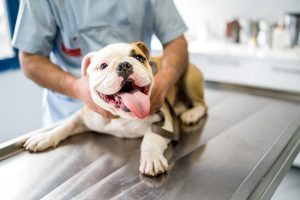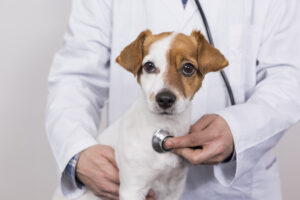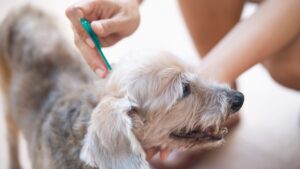Posts Tagged ‘new animal’
Dr. Olsen’s Pet Spotlight: The Leonberger Dog Breed
 At Olsen Veterinary Clinic, we celebrate all breeds, and today, we’re delighted to spotlight the Leonberger—a breed renowned for its gentle temperament, impressive size, and striking appearance. Whether you are a seasoned dog owner or considering adding a Leonberger to your family, understanding this breed’s unique characteristics is essential.
At Olsen Veterinary Clinic, we celebrate all breeds, and today, we’re delighted to spotlight the Leonberger—a breed renowned for its gentle temperament, impressive size, and striking appearance. Whether you are a seasoned dog owner or considering adding a Leonberger to your family, understanding this breed’s unique characteristics is essential.
Origin and History
The Leonberger hails from Leonberg, Germany, where Heinrich Essig, a dog breeder, sought to create a breed that embodied the grandeur and loyalty of a lion. By crossbreeding Saint Bernards, Newfoundlands, and Great Pyrenees, Essig succeeded in developing the Leonberger, which soon became a favorite among European royalty. The breed was officially recognized in the late 19th century and has since garnered a loyal following worldwide.
Physical Characteristics
Leonbergers are a sight to behold. Males typically weigh between 110 to 170 pounds, while females range from 90 to 140 pounds. They stand 26 to 32 inches tall at the shoulder, exuding an aura of strength and nobility. Their dense, water-resistant double coat comes in shades of lion-yellow, golden to red-brown, often with a black mask. Regular grooming is essential to maintain their majestic coat and reduce shedding.
Temperament and Behavior
Despite their imposing size, Leonbergers are known for their gentle and friendly nature. They are affectionate, loyal, and thrive on human companionship, making them excellent family pets. Their intelligence and eagerness to please make them highly trainable, although early socialization and obedience training are crucial. Leonbergers are known for their calm demeanor, but they also possess a playful side and enjoy various activities, from hiking to swimming.
Health and Lifespan
Leonbergers are generally healthy, with a lifespan of 8 to 10 years. However, like all breeds, they are prone to specific health issues, including hip dysplasia, elbow dysplasia, and certain types of cancer. Regular veterinary check-ups, a balanced diet, and appropriate exercise are vital to ensuring their well-being. At Olsen Veterinary Clinic, we emphasize preventative care and offer tailored health plans to keep your Leonberger in optimal condition.
Exercise and Activity
Given their size, Leonbergers require regular exercise to maintain their physical and mental health. Daily walks, play sessions, and opportunities to run in a secure area are beneficial. They excel in activities like agility, obedience, and even water rescue, thanks to their strong swimming abilities. Engaging your Leonberger in diverse activities will keep them happy and prevent boredom-related behaviors.
Grooming Needs
Leonbergers have a thick, double coat that requires consistent grooming. Weekly brushing helps prevent mats and tangles, and more frequent grooming may be necessary during shedding seasons. Bathing should be done as needed, and regular checks of their ears, teeth, and nails are essential parts of their grooming routine. At Olsen Veterinary Clinic, we offer comprehensive grooming services to help keep your Leonberger looking and feeling their best.
Leonbergers and Families
Leonbergers are known for their exceptional compatibility with families. They are patient and gentle with children, often forming strong bonds with them. Their protective yet non-aggressive nature makes them excellent watchdogs without being overly territorial. However, due to their size, supervision around small children is recommended to prevent accidental knock-overs.
The Leonberger is a remarkable breed that combines beauty, strength, and a loving temperament. They make wonderful companions for those who can accommodate their size and grooming needs. At Olsen Veterinary Clinic, we are passionate about providing the best care for your Leonberger, ensuring they lead a healthy, happy life. Whether you’re a current Leonberger owner or considering bringing one into your home, our team is here to support you with expert advice and services.
For more information or to schedule a consultation, please contact Olsen Veterinary Clinic. We look forward to helping you and your Leonberger thrive together.
Understanding Pet Vaccinations: Ensuring Your Pet’s Health
 As pet owners, we all want our furry companions to live long, healthy, and happy lives. One of the most crucial aspects of maintaining your pet’s health is ensuring they receive the appropriate vaccinations. At Olsen Veterinary Clinic, we believe in educating pet owners about the importance of vaccinations, the recommended vaccination schedule, and how these preventive measures contribute to your pet’s overall well-being.
As pet owners, we all want our furry companions to live long, healthy, and happy lives. One of the most crucial aspects of maintaining your pet’s health is ensuring they receive the appropriate vaccinations. At Olsen Veterinary Clinic, we believe in educating pet owners about the importance of vaccinations, the recommended vaccination schedule, and how these preventive measures contribute to your pet’s overall well-being.
Why Are Pet Vaccinations Important?
Vaccinations are vital for protecting pets from various infectious diseases, some of which can be life-threatening. These vaccines work by stimulating the immune system to recognize and fight specific pathogens, such as viruses and bacteria, if your pet is exposed to them in the future. Here are some key reasons why vaccinations are essential:
1. Disease Prevention
Vaccines help prevent numerous diseases that can affect pets. For example, canine parvovirus, distemper, and rabies in dogs, and feline leukemia virus and panleukopenia in cats, are all preventable through vaccination.
2. Public Health
Some diseases that affect pets, like rabies, can be transmitted to humans. By vaccinating your pet, you are also protecting yourself, your family, and your community from potential zoonotic diseases.
3. Legal Requirements
In many areas, certain vaccinations, such as rabies, are required by law. Ensuring your pet is up-to-date with their vaccines helps you stay compliant with local regulations.
4. Cost-Effective Health Care
Preventing diseases through vaccination is often far less expensive than treating the diseases once they occur. Regular vaccinations can save you from costly treatments and emergency vet visits.
Recommended Vaccination Schedule
At Olsen Veterinary Clinic, we follow a vaccination schedule that aligns with the guidelines set by veterinary health authorities. Here is a general outline of the recommended vaccination schedule for dogs and cats:
For Puppies and Dogs:
- 6-8 weeks:
- Distemper
- Parvovirus
- Adenovirus (Hepatitis)
- Parainfluenza
- 10-12 weeks:
- Booster for Distemper, Parvovirus, Adenovirus, and Parainfluenza
- Bordetella (Kennel Cough)
- 14-16 weeks:
- Booster for Distemper, Parvovirus, Adenovirus, and Parainfluenza
- Rabies
- 1 year and annually thereafter:
- Annual boosters for Distemper, Parvovirus, Adenovirus, Parainfluenza, and Rabies
- Optional: Lyme disease, Leptospirosis, and Influenza based on your dog’s risk factors
For Kittens and Cats:
- 6-8 weeks:
- Feline Viral Rhinotracheitis (FVR)
- Calicivirus (FCV)
- Panleukopenia (FPV)
- 10-12 weeks:
- Booster for FVR, FCV, and FPV
- Feline Leukemia Virus (FeLV)
- 14-16 weeks:
- Booster for FVR, FCV, FPV, and FeLV
- Rabies
- 1 year and annually thereafter:
- Annual boosters for FVR, FCV, FPV, FeLV, and Rabies
How Vaccinations Contribute to Your Pet’s Well-Being
Regular vaccinations play a crucial role in maintaining your pet’s overall health and well-being. Here’s how:
1. Boosts Immunity
Vaccines strengthen your pet’s immune system, making them more capable of fighting off infections and reducing the severity of illnesses if they do occur.
2. Reduces Disease Spread
By vaccinating your pets, you are helping to control the spread of contagious diseases within the pet population. This is particularly important in communal settings like parks, boarding facilities, and grooming salons.
3. Improves Quality of Life
Healthy pets are happy pets. Vaccinations protect against debilitating diseases that can significantly reduce your pet’s quality of life, ensuring they stay active and vibrant.
4. Longevity
Preventive care, including regular vaccinations, has been proven to extend the lifespan of pets. By safeguarding them against diseases, you are giving your pet the best chance at a long, healthy life.
At Olsen Veterinary Clinic, we are committed to providing the highest standard of care for your pets. Vaccinations are a cornerstone of preventive health care, and we encourage all pet owners to adhere to the recommended vaccination schedules. By doing so, you are not only protecting your pet but also contributing to the overall health of the animal community.
If you have any questions about your pet’s vaccination needs or would like to schedule an appointment, please contact us at Olsen Veterinary Clinic. Together, we can ensure your pet’s health and happiness for years to come.
The Importance of Regular Veterinary Check-ups
 Regular veterinary check-ups are crucial for maintaining the overall health and well-being of your pets. These routine visits play a key role in preventative care and early detection of health issues. Here are some reasons why regular veterinary check-ups are important.
Regular veterinary check-ups are crucial for maintaining the overall health and well-being of your pets. These routine visits play a key role in preventative care and early detection of health issues. Here are some reasons why regular veterinary check-ups are important.
Preventative Care:
Regular check-ups allow veterinarians to administer vaccinations, parasite control, and dental care. Preventative measure can help protect your pet from various illnesses, ensuring they lead a healthier longer life.
Early Detection of Health Issues:
Pets, like humans, can develop health issues that may not be immediately apparent. Regular check-ups enable veterinarians to detect potential health problems early, often before symptoms become severe. Early detection can significantly improve the prognosis and treatment outcomes.
Disease Screening:
Veterinary check-ups may include screenings and tests for common pet diseases. These screenings can help identify conditions such as diabetes, kidney disease, and certain types of cancer in their early stages, allowing for timely intervention.
Dental Health:
Dental issues are common in pets, and they can lead to various health problems if left untreated. Regular veterinary visits often include dental examinations and cleanings, promoting good oral health and preventing dental diseases.
Nutritional Guidance:
Veterinarians can provide guidance on proper nutrition based on your pet’s age, breed, and health condition. A well-balanced diet is essential for maintaining your pet’s overall health and preventing nutrition-related issues.
Behavioral Assessment:
Veterinarians can assess your pet’s behavior during routine visits. Changes in behavior may be indicative of underlying health issues and addressing them early can prevent further complications.
Weight Management:
Maintaining a healthy weight is crucial for your pet’s well-being. Regular check-ups allow veterinarians to monitor your pet’s weight and provide guidance on nutrition and exercise to prevent obesity-related health issues.
Senior Pet Care:
As pets age, their healthcare needs may change. Regular check-ups become even more critical for senior pets to monitor and address age-related conditions, such as arthritis, dental problems, and organ dysfunction.
Client Education:
Veterinary visits are an opportunity for pet owners to learn about their pet’s specific needs, behaviors, and potential health risks. Education from veterinarians empowers pet owners to provide the best care possible.
In summary, regular veterinary check-ups are essential for preventative care, early detection of health issues, and ensuring that your pets lead healthy and happy lives. Establishing a consistent schedule of veterinary visits can contribute significantly to the overall well-being of your beloved companions. Contact our office today to schedule yours or if you have any questions.
Is My Cat Sleeping Too Much? How to Know the Difference Between a Cat Nap and a Problem
 Cats are known for sleeping a lot, and it’s perfectly normal for them to spend a significant portion of their day napping. On average, cats can sleep anywhere from 12 to 16 hours a day and some cats may sleep even more, especially if they are very young or very old. However, if you’re concerned that your cat is sleeping too much and it might be a sign of a problem, here are some things to consider:
Cats are known for sleeping a lot, and it’s perfectly normal for them to spend a significant portion of their day napping. On average, cats can sleep anywhere from 12 to 16 hours a day and some cats may sleep even more, especially if they are very young or very old. However, if you’re concerned that your cat is sleeping too much and it might be a sign of a problem, here are some things to consider:
- Changes in Behavior: Pay attention to any noticelable changes in your cat’s behavior. If your cat is typically active, playful, and social when awake but suddenly becomes lethargic or withdrawn, it could be a sign of an underlying issue.
- Appetite and Thirst: Monitor your cat’s eating and drinking habits. A significant decrease in appetite or a noticeable increase in thirst can be indicators of a health problem.
- Weight Changes: Sudden weight loss or gain can be a sign of various health issues, so keep an eye on your cat’s weight.
- Bathroom Habits: Changes in litter box habits, such as straining to urinate, diarrhea, or constipation, may indicate a problem. Also, observe the color and consistency of your cat’s urine and feces.
- Physical Symptoms: Look for physical signs of distress, such as vomiting, coughing, sneezing, limping, or any obvious discomfort or pain. These can be clues that something is amiss.
- Age and Health History: The age and overall health of your cat can also influence their sleeping patterns. Senior cats may sleep more than younger cats. Consult with your veterinarian to discuss age-related changes in your cat’s behavior.
- Environmental Factors: Ensure your cat’s environment is comfortable and stress-free. Changes in your cat’s living situation, such as moving to a new home, introducing a new pet, or household routine, can affect their behavior and sleep patterns.
- Regular Veterinary Check-Ups: Regular veterinary check-ups are essential for maintaining your cat’s health. If you’re concerned about your cat’s excessive sleeping or any other changes, consult your veterinarian. They can perform a physical examination, run diagnostic tests, and provide guidance of your cat’s specific needs.
Obviously, you know your cat better than anyone. So if you have any concerns or questions about your fur baby, don’t hesitate to contact our office today to set up a visit.
How to Choose the Right Flea and Tick Medicine for Your Dog
 With the weather being nice, people and pets are tired about being cooped up inside. They are starting to enjoy the fresh air, the calm breezes in their face and the warmth of the sun. But whether it is a walk in the park, a weekend camping along the lake or even lounging around your front yard, fleas and ticks could be waiting to latch onto your pet and hitch a ride. So because of this, application of a flea and tick control or collar is essential to prevent them from infesting your home.
With the weather being nice, people and pets are tired about being cooped up inside. They are starting to enjoy the fresh air, the calm breezes in their face and the warmth of the sun. But whether it is a walk in the park, a weekend camping along the lake or even lounging around your front yard, fleas and ticks could be waiting to latch onto your pet and hitch a ride. So because of this, application of a flea and tick control or collar is essential to prevent them from infesting your home.
There are many factors to consider when choosing the optimal product. One must decide if they want a collar, topical or chewable tablet. Each one has their pro’s and con’s about them. The collars and topical products such as Frontline or Advantage have been around a lot longer and may be less expensive to buy, but we have seen breaks in protection because the fleas and ticks have gained resistance or the product has not been used properly. Some of those products are approved by the EPA so they might not be safe to use on your pet. Recently new products such as Nexguard or Bravecto have been developed that are taken orally. Because they are newer products, the fleas and ticks have not developed a resistance to them. Also since they are ingested, they are approved by the FDA to assure their safety to the pet.
There are several oral products available like Simperica Trio that will also control other parasites, along with fleas and ticks. So they may be more expensive but be more convenient in the long run.
The best thing to do is to have a conversation with your vet about what is best for your pet, as well as what works for you financially. We are happy to have a conversation about any concerns you have. Prevention is key, so make sure to protect your furry companion this summer. Contact our offices today!
National Pet Theft Awareness Day
 Our pets are very important to us and we rely on them for comfort and support every day. So it is devastating and hard to believe that a pet would be stolen. Every year about 2 million pets go missing with only about 10 percent returned home. These figures have alarmingly risen about 37 percent since 2007. So in honor of National Pet Theft Awareness Day which is being celebrated on February 14, I am going to blog about why they are stolen and how to reduce the possibility of your pet being dog- or cat- napped.
Our pets are very important to us and we rely on them for comfort and support every day. So it is devastating and hard to believe that a pet would be stolen. Every year about 2 million pets go missing with only about 10 percent returned home. These figures have alarmingly risen about 37 percent since 2007. So in honor of National Pet Theft Awareness Day which is being celebrated on February 14, I am going to blog about why they are stolen and how to reduce the possibility of your pet being dog- or cat- napped.
There are quite a few reasons why someone may steal a pet. According to PetFBI, these are the most common:
- Pet Flipping: Popular breeds of dogs can be “resold” online or in the paper.
- Reward: Some pets are stolen in hopes the owner will offer a reward, which the thief will then claim
- Puppy Mills: Pets that have not been spayed or nuetered may be turned over to backyard breeders or puppy mills
- Dog Fighting Rings: Small dogs and cats have been stolen to be used as “bait” for dog-fight training. The large breed dogs are often used as dog fighting candidates.
- Neighbors: If pets have been known as “nuisances” neighbors have been known to take animals and dump them in other locales.
- Relatives: Sadly, many pet thefts come from family members who are upset with you like in a divorce or family dispute
- Good Intentions: Not all pet-nappings are maliscious. A good-hearted person may believe that they are helping your pet if they feel that the pet is being neglected in some way. This is why you never leave your pet tied up in your yard, keeping them outside only, or have a pet that has signs of being neglected.
There are steps that owners can take to prevent their pets from being stolen. First and foremost, HAVE YOUR PET MICROCHIPPED and make sure that their records are updated. Remember that the microchip is only as good as the registration, so make sure that they are microchipped. In addition, you can:
- Your pets should not be allowed to run free outdoors unattended and make sure that your pets are always wearing a collar and identification.
- Spay and neuter your pets
- Don’t tie up your dog outside of a restaurant or store and never leave your pet in a car.
- Keep dog doors and fence gates locked when you are not at home.
- Have updated photos of your pet with emphasis on special markings
- Install cameras. Indoor and outdoor camera networks are ideal for keeping your pet safe.
Nothing is scarier or upsetting to come home and find your pet missing. It is of most importance to act quickly as every minute matters when you are looking for your pet, whether they have escaped from your yard or have been dog-napped.
If you believe that they have been stolen, immediately report it to the police. This provides a record that is documented and can be used for further action. It is important to canvas the area on foot every day. Creating a “Lost Pet” poster and placing throughtout the community helps others watch for your pet in cars, on the street or at neighbors. Post a lost pet report through your microchip company and your animal control. Avoid posting a reward is being offered.
If you have any other questions about microchipping or keeping your pet safe, do not hesitate to contact our office today.
New Puppy Checklist: Everything You Need Before Welcoming Your New Furry Friend into Your Life
 Bringing a new puppy into your home is an exciting time but requires some preparation for your home. Puppies require a lot of attention and care, so this checklist will be beneficial if you are unsure where to start with the basics for your new puppy.
Bringing a new puppy into your home is an exciting time but requires some preparation for your home. Puppies require a lot of attention and care, so this checklist will be beneficial if you are unsure where to start with the basics for your new puppy.
Some companies have created puppy starter kits. For example, this box made by Chewy has a set of toys, treats, and potty-training materials to help you with your new puppy. All top-rated items, new puppy owners are sure to appreciate it. It also makes a great gift. It can be found here.
Beyond toys, treats, and potty-training materials, puppies need food and water bowls. There are a lot of different options, but one that is slightly lifted is easier for your puppy to eat from. If you get one with walls, it is more likely your floor will stay cleaner.
Also necessary is a bed for your pet. An elevated bed is good for keeping your dog lifted and is helpful for teaching different cues. Other more traditional options are great too, especially as your pups are growing quickly.
Some owners choose to crate their puppies, and there are a lot of options but must be replaced as dogs grow. Crates help dogs have a safe place, especially as they adjust to a new space and lifestyle.
Also important for your new puppy is a leash. There are many kinds of leashes, with different uses. It will most likely be trial and error to find what works for you and your puppy, so be prepared for a trial period.
Puppies require hygiene efforts. This includes toothbrushes, toothpaste, nail clippers, brushes, and bathing supplies. Providing exposure to these items while young makes it less scary for adult dogs and easier for their owners.
Lastly, a collar is a great way to express your and your pet’s personality. Be prepared for your new pup with a collar and tag to provide some protection and peace of mind.
The last step for a new puppy is establishing an appointment with your veterinarian to get started on vaccinations and discuss your new dog’s life! Feel free to contact Dr. Olsen of Olsen Veterinary Clinic at 618-656-5868 to set up an appointment or discuss any questions!
2022 Pet Gift Guide
 Don’t leave your pet out of the holiday fun! Furry friends like to open gifts too! Here are a few options to show your four-legged pal some love.
Don’t leave your pet out of the holiday fun! Furry friends like to open gifts too! Here are a few options to show your four-legged pal some love.
The Pupsicle is a great opportunity to give your dog a new treat experience. You freeze your dog’s favorite food in the mold, then when it is time for a treat, you put the frozen treat in the Pupsicle. When they’re done, you’re able to open the ball, wash it, and repeat! Find it here.
You can liven up your cat’s drinking experience with a cat fountain. Some cats enjoy moving water more than still, and a plastic cat fountain such as this one here circulates water for cats to drink.
Say you want to get a gift for your favorite pet owner in your life. The company West and Willow makes custom pet portraits that any pet owner will be sure to love. You can find them linked here.
Social media has allowed several pets to become Tik Tok famous. Pets have been trained to use buttons programmed with specific words to communicate with their owners. You can find a starter kit here to try your pet’s hand at internet fame.
For cats that love to play but whose owners don’t love obnoxiously bright-colored toys laying around the house, these handmade cat toys from an Etsy seller are stylish and aesthetically pleasing. They are environmentally friendly as well, made from leftover upholstery fabric. These toys are filled with grounds of a plant called silvervine which is like catnip. If your cat doesn’t really like regular catnip, silvervine is a great alternative. Find these toys here.
Whether you are looking for a gift for your furry friend or a close pet-lover, these gifts are sure to please all. Feel free to contact Dr. Olsen at Olsen Veterinary Clinic at 618-656-5868 with any questions!
Dr. Olsen’s Breed Spotlight: The Tibetan Mastiff

Tibetan Mastiff
The Tibetan Mastiff is a large-size Tibetan dog breed. It has a medium to long double coat and is found in many colors. These can be solid black, black and tan, various shades of red (from pale gold to deep red), and bluish gray. Sometimes, they can have white markings around their neck, chest, and legs.
The term mastiff goes back to when the Europeans first went to Tibet. They used the term to refer to nearly all large dog breeds in the West. Early Western visitors misnamed several of its breeds through this process. For example, the Tibetan terrier is not a terrier, and the Tibetan spaniel is not a spaniel.
In the early 20th century, the Prince of Wales, George, introduced a pair of Tibetan Mastiffs to the United Kingdom, which caused the breed to become prevalent enough in England to be shown at the Crystal Palace show in 1906. Since 1980, the breed has been gaining in popularity worldwide.
The Tibetan Mastiff is a primitive breed and retains the general hardiness that would be required of them to survive in the harsh environment of Tibet, Ladakh, and other high-altitude Himalayan regions. Because of this, they tend to have strong instinctive behavior, including canine pack behaviors. These help the breed survive in harsh environments. It has maintained many of the same biological processes as wolfs and other animals.
The dog has a long, double coat whose length depends ultimately on the climate. Uniquely, the Tibetan Mastiff lacks the unpleasant big-dog smell that affects many other large dog breeds. Their coat can shed dirt and odors on its own. Many of the dogs shed somewhat throughout the year, but there is generally one great molt in late Winter or early Spring.
Tibetan Mastiffs have a life expectancy of around 10-16 years, but this span can vary. Generally, the breed has fewer genetic health problems than many other breeds. However, cases can be found of hypothyroidism, entropion, ectropion, distichiasis, skin problems, etc. As with most large breeds, some will suffer from elbow or hip dysplasia.
Hypothyroidism is common in Tibetan Mastiffs, along with many other large “northern” breeds. They should be tested periodically throughout their lives using a complete thyroid panel. However, because the standard thyroid levels were established using domestic dog breeds, test results must be considered in the context of what is “normal” for the breed, not what is standard for all breeds. Many Tibetan Mastiffs will have “low” thyroid values, but no clinical symptoms. Vets and owners differ on the relative merits of medicating dogs that test “low” but are completely asymptomatic.
The Tibetan Mastiff is sure to be a large lovable friend for any owner. Feel free to contact Dr. Olsen at Olsen Veterinary Clinic with any questions at 618-656-5868.
CBD For Your Dog: What You Need To Know
 CBD can work wonders for dogs in oils or dog treats. CBD can provide the same benefits for dogs as medical marijuana for humans who experience seizures, extreme pain, anxiety, and cancer. CBD is not what you may traditionally view as weed. CBD is not psychoactive, unlike its more famous counterpart, THC (tetrahydrocannabinol). CBD is one of over 80 different chemical compounds called “cannabinoids” derived from the marijuana plant. Instead, CBD shares important metabolic pathways with a class of drugs called NSAIDs (non-steroidal anti-inflammatory drugs) like ibuprofen and Rimadyl. These pathways control many processes in the body, from inflammatory responses to blood clotting. Never give dogs straight marijuana or any product containing THC, the primary psychoactive component of marijuana. However, CBD-based products can substantially improve your dog’s quality of life when used in conjunction with other therapies.
CBD can work wonders for dogs in oils or dog treats. CBD can provide the same benefits for dogs as medical marijuana for humans who experience seizures, extreme pain, anxiety, and cancer. CBD is not what you may traditionally view as weed. CBD is not psychoactive, unlike its more famous counterpart, THC (tetrahydrocannabinol). CBD is one of over 80 different chemical compounds called “cannabinoids” derived from the marijuana plant. Instead, CBD shares important metabolic pathways with a class of drugs called NSAIDs (non-steroidal anti-inflammatory drugs) like ibuprofen and Rimadyl. These pathways control many processes in the body, from inflammatory responses to blood clotting. Never give dogs straight marijuana or any product containing THC, the primary psychoactive component of marijuana. However, CBD-based products can substantially improve your dog’s quality of life when used in conjunction with other therapies.
CBD can help with many ailments your dog may experience such as pain management, arthritis, anxiety, seizures, and even cancer. Because CBD shares the same metabolic pathways as anti-inflammatory drugs, it can help with inflammatory conditions. Anything that ends in “-itis” is an inflammatory condition. This includes osteoarthritis (arthritis for short). 25% of dogs will be diagnosed with arthritis in their lifetime. By some estimates, as many as 60% of dogs exhibit some degree of the disease. CBD can provide relief for dogs that may be experiencing pain.
With any treatment, there are potential risks. Overall, CBD itself seems to be incredibly safe for both dogs and cats. However, it has been found that when given at the recommended doses, CBD does cause an elevation in an important liver value on bloodwork called alkaline phosphatase (ALP). It is too early in its research to see if the elevation in this liver value has any medical significance. It could signify that CBD causes irritation or damage to the liver. Alternatively, it could be an artificial finding in which the drug interferes with the way the lab measures the liver value. It is simply too early to know for sure. There are anecdotal reports of dogs becoming somewhat sleepy or sedate if they receive a large dose of CBD, but these effects resolve independently with time. Moreover, CBD doesn’t appear to have any drug interactions when given to a dog on an anti-inflammatory drug like Rimadyl. However, there is a theoretical risk of drug interaction, as with any other medication, so it is essential to consult with your veterinarian before treating your dog with CBD.
CBD can be administered in topical treatments; however, it is most often administered orally to dogs. The correct dosage is imperative. Studies on using CBD for dogs with arthritis or seizures generally use a dose between 2-8 mg/kg, with most papers erring on the lower side of that estimate. This is about 1-2 milligrams per pound of body weight, twice daily. This dosage has been found to be safe and effective for use with arthritis and seizures. Additional research is needed to evaluate the differences in CBD dosages for other conditions.
CBD can provide benefits for your dog that may be experiencing pain or anxiety. However, the correct dosage is imperative. If you have any questions, feel free to contact Dr. Olsen at Olsen Veterinary Clinic at 618-656-5868.
